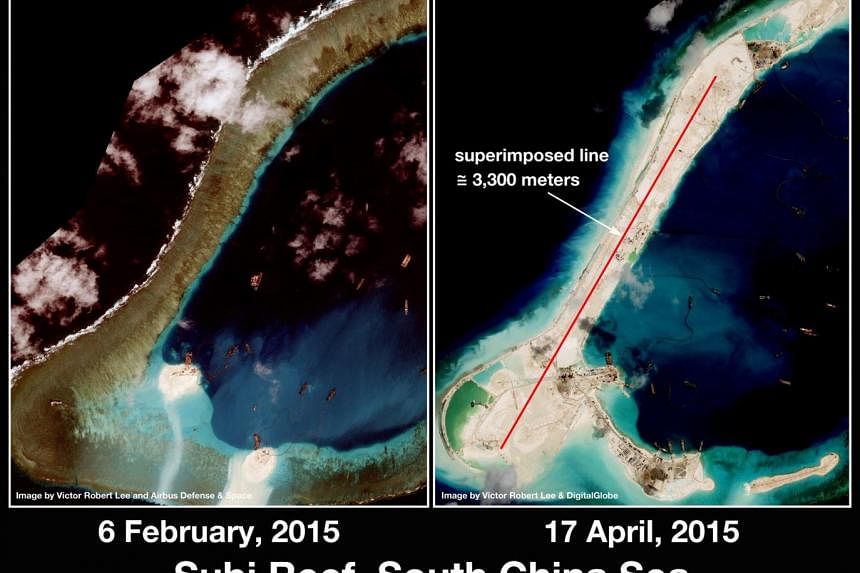China's intrusion into Malaysian waters may have been more extensive than Kuala Lumpur has acknowledged, new surveillance photos have shown.
A new satellite image posted on Friday (June 19) by current affairs website The Diplomat showed that a 4,000-tonne, 3401-class Chinese Coast Guard ship had been operating close to Luconia shoals 150km north of Malaysian Borneo.
This is the same type of vessel China has used to wrestle control of Scarborough shoal from the Philippines in 2012, and to enforce a blockade around a Philippine-held position in Second Thomas shoal.
In the photo taken on Feb 13 this year, the Chinese ship could be seen sitting 3.5km from an elevated coral sediment feature called the Luconia breakers, well inside Malaysia's 400-km exclusive economic zone. Anchored nearby was a Malaysian Navy Kedah-class patrol vessel.
Malaysia's National Security Minister Shahidan Kassim earlier posted photos on his Facebook page that showed a smaller 1,000-tonne Chinese law enforcement ship anchored at Luconia shoals, near the southern extreme of China's so-called nine-dash line.
China is claiming territories inside this line which spans 90 per cent of the 3.5-million-sq-km South China Sea.
Apart from Malaysia, the Philippines, Vietnam, Taiwan and Brunei are also claiming parts of this sea.
"By not revealing this shadowing of the more threatening Chinese ship, Malaysia may wish to avoid a full-fledged standoff like the one that resulted in the Philippines losing Scarborough shoal in 2012," defence analyst Victor Robert Lee said.
He added that Kuala Lumpur "may also be weighing whether over time it can benefit from a counter-balance from the US and its allies".
Admiral Abdul Aziz Jaafar, chief of Malaysia's navy, disclosed earlier that intrusions by Chinese ships into waters very close to the Malaysian coast had been occurring daily since last year. Kuala Lumpur protested these intrusions, but the Chinese vessel involved in the latest incident had remained in Malaysian waters, he said.
Malaysia has taken a generally low-key approach in South China Sea disputes, unlike the Philippines and Vietnam, which have directly challenged China with skirmishes at sea and a case before an international arbitration court.
Malaysia has allowed China to hold naval drills near James shoal, one of seven rocky outcrops and islands it is claiming in the Spratly archipelago in the southern half of the South China Sea.
Unlike Luconia, James shoal is inside China's nine-dash line.
Latest satellite images, meanwhile, reveal that China continues to dredge sand and coral to expand its holdings on Subi and Mischief reefs in the Spratlys.
Surveillance photos taken by mapping firm Digital Global on June 5 showed that the Chinese had managed to add 3 hectares a day on Subi over two months.
Mr Lee said terrain-grading patterns on the island resembled those on Fiery Cross reef, suggesting that China is also building a 3-km long runway on Subi.
Separate images taken on June 10 and released by the Asia Maritime Transparency Initiative showed that Mischief is now half filled in, with over 5.42 million sq km already reclaimed.
Beijing had announced that its land reclamation project in the Spratlys "will be completed in the upcoming days".
The Diplomat reported that based on the latest available satellite images, China has finished dredging and landfilling works on Fiery Cross, Gaven, Hughes, Cuarteron and Johnson South.
An airstrip has been built on Fiery Cross, and 5m-by-40m ramps can be seen on Gaven, Hughes, Cuarteron and Johnson South.
The ramps could be part of two-storey garages that can house mobile artillery units.
The US and Japan have no territorial claims in the South China Sea, but they are worried that China, through its now nearly completed chain of man-made islands, may gain control of international waterways through which over US$5 trillion (S$6.6 trillion) in ship-borne trade passes.
The two nations are set to hold simultaneous naval drills in the Philippines this week (June 22 to 25) near contested waters.


